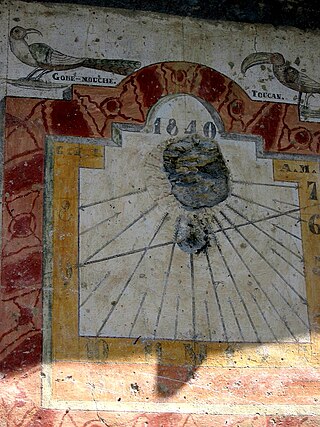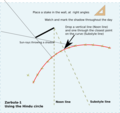Top Qs
Timeline
Chat
Perspective
Giovanni Francesco Zarbula
From Wikipedia, the free encyclopedia
Remove ads
Giovanni Francesco Zarbula was a mural painter and sundial designer from Piedmont Italy who created a hundred or more vertical and vertical declining sundials in the French and Italian Alpes between 1830 and 1881. He worked exclusively in Savoy, in Piémont, the Valley of the Ubaye, le Queyras and around Briançon. [1]

Laying out the dial
Summarize
Perspective
Zarbula's method was one of observation rather than geometric construction. He did not need to know the latitude or declination of the wall, he did not use tables or calculations; he simply worked directly on the wall. All his dial were within 2° of the 45th parallel, simplifying the construction, and all gave five-minute accuracy.
- With a plumb bob he drew a vertical line on the wall, the "Noon Line".
- He hammered a rod into the wall at right angles to the vertical, the "centre of the dial" C
- He observed and marked the shadow cast by the tip of that rod throughout a day, the hyperbolic declination line.[a]
- Using a set of compasses, he determined the line of symmetry on the wall.[b], the "substyle line".[c]
All the rest of the dial was laid out using a 45° square, with a 15° measure at the end. [d]
- He drew a horizontal line at a point of choice on the dial plate, the "horizon".
- The square was placed on the substyle facing outwards, sliding into any convenient position where it cuts the horizon. He drew a perpendicular line drawn to that point, the "equatorial". A line was drawn from that point to the centre of the dial, the 18h line (or 6h depending on the declination (d) of the wall). The points where the equatorial crosses the noon line and the substyle line were important.
- He placed the apex of the square on the substyle line, so the sides passed through the equatorial points (12h and 18h markers). The apex point is called the "auxiliary equatorial centre".
- A protractor or squares [e] drew off 15° intervals on the equatorial. These were connected to the centre of the dial: the hour lines. The distance from the auxiliary equatorial centre to the equatorial formed the substyle height at that point.[2][3]
Remove ads
The colours
Zarbula treated his paintings as frescos so the body colour was embedded in the supporting lime mortar. He didn't use organic pigments, just oxides. These do not fade in the strong alpine sunlight.
Existing Dials (cadrans)
Summarize
Perspective
Of the hundred dials by Zarbula, about 50 have survived, and a further dozen show visible traces.[4] In Hautes-Alpes, seven dials are protected as monument historique.[5]
His dials can be divided into three specific styles Öiseau (Birds), Geometric, Baroque. The birds that appear in the dials of the early 1840s include toucans, jabirus, parakeets and other exotic birds not seen in these mountains. The geometric works of the late 1840s and 1850s are noted or their simplicity, and contain a little trompe-l'œil to give the design some artificial depth. The baroque dials are contain birds, vases, full trompe-l'œil and false-marbling. They contain the symbols of the Second Empire (1852-1870) and Napoleon III particularly the Imperial Eagle. The dials produced after 1865 include the Masonic device of the Square and Compasses: this is co-incidental to the rise and acceptance of masonry on both sides of the Italian French border.[6]
Remove ads
References
External links
Wikiwand - on
Seamless Wikipedia browsing. On steroids.
Remove ads






